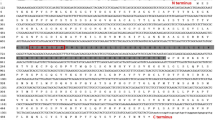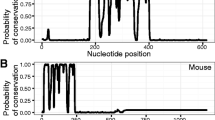Members of the Sox gene family are characterized by an HMG-box that shows sequence similarity with that of the mouse testis-determining gene Sry. Using degenerate primers PCR, seven and eight HMG-box motifs of Sry-related genes were cloned and sequenced from genomic DNA of Trionyx sinensis (termed TS41-47) and Alligator sinensis (AS41-48) with TSD (temperature-dependent sex determination). Among 15 Sry-related genes, TS41, TS42, AS41, and AS42 shared 80, 72, 81, and 79% amino acid identity, respectively, with each HMG-box domain of the mouse Sox-1, -2, and -3 genes by Blast analysis. Molecular phylogenetic analysis showed that the clustering of TS41-42 and AS41-42 was distant to the clustering of the nonreptilian vertebrate Sox-1, -2, -3 homologs, including fish, amphibian, bird, and mammals. The amino acid identity among TS41-42, AS41-42, and the nonreptilian vertebrate Sox-1, -2, -3 homologs is lower than identities among the Sox-1, -2, -3 homologs, suggesting that the sequence changes in TS41-42 of Trionyx sinensis and AS41-42 of Alligator sinensis might have occurred after the diversification of amniotes.



Similar content being viewed by others
REFERENCES
Coriat, A. M., Muller, U., Harry, J. L., Uwanogho, D., and Sharpe, P. T. (1993). PCR amplification of SRY-related gene sequences reveals evolutionary conservation of the HMG-box motif. PCR Meth. Appl. 2:218.
Coriat, A. M., Valleley, Z., Ferguson, M. W. J., and Sharpe, P. T. (1994). Chromosomal and temperature-dependent sex determination: The search for a conserved mechanism. J. Exp. Zool. 270:112.
Cremazy, F., Soullier, S., Berta, P., and Jay, P. (1998). Further complexity of human SOX gene family revealed by the combined use of highly degenerate primers and nested PCR. FEBS Lett.. 438:311.
Denny, P., Swift, S., Conner, F., and Ashworth, A. (1992). An SRY-related gene expressed during spermatogenesis in the mouse encodes a sequence-specific DNA-binding protein. EMBO J. 11:3705.
Griffiths, R. (1991). Isolation of conserved DNA sequences related to the backed gull. Proc. R. Soc. Lond. B 244:123.
Gubbay, J., Collignon, J., Koopman, P., Capel, B., Economou, A., Munsterbery, A., Vivian, N., Goodfellow, P., and Lovell-Badge, R. (1990). A gene mapping to the sex-determining region of the mouse Y chromosome is a member of a novel family of embryonically expressed genes. Nature 46:245.
Kamachi, Y., Uchikawa, M., Colligon, J., Lovell-Badge, R., and Kondoh, H. (1998). Involvement of Sox-1, -2, and -3 in the early and subsequent molecular events of lens induction. Development 125:2521.
Kent, J., Wheatley, S. C., Andrews, J. E., Sinclair, A. H., and Hoopman, P. (1996). A male-specific role Sox9 in vertebrate sex determination. Development 122:2813.
Koopman, P., Gubbay, J., Vivian, N., Goodfellow, P., and Lovell-Badge, R. (1991). Male development of chromosomally female mice transgenic for Sry. Nature 351:117.
Kumar, S., Tamura, K., Jakobsen, I. B., and Nei, M. (2001). MEGA 2.1: Molecular Evolutionary Genetics Analysis software. Bioinformatics 17:1244–1245.
Laudet, V., Stephelin, D., and Clevers, H. (1993). Ancestry and diversity of the HMG box superfamily. Nucl. Acids Res. 21:2493.
Morais da Silva, S., Hacker, A., Harley, V., Goodfellow, P., Swain, A., and Lovell-Badge, R. (1996). Sox9 expression during gonadal development implies a conserved role for the gene in testis differentiation in mammals and birds. Nat. Genet. 14:62.
Nagai, K. (2001). Molecular evolution of Sry and Sox gene. Gene 270:161.
Pevny, L. H., and Lovell-Badge, R. (1997). Sox gene find their feet. Curr. Opin Genet. Dev. 7:338.
Saitou, N., and Nei, M. (1987). The neighbor-joining method: A new method for reconstructing phylogenetic trees. Mol. Biol. Evol. 4:406.
Schepers, G. E., Bullejos, M., Hosking, B. M., and Koopman, P. (2000). Cloning and characterization of the Sry-related transcription factor gene Sox8. Nucleic Acids Res. 28:1473.
Spotila, L. D., Kaufer, N. F., Theriot, E., Ryan, K. M., Penick, D., and Spotila, J. R. (1994). Sequence analysis of the ZFY and Sox genes in the turtle Chelydra serpentina. Mol. Phylogenet. Evol. 3:1.
Spotila, L. D., Spotila, J. R., and Hall, S. E. (1998). Sequence and expression analysis of WTl and Sox9 in the red-eared slider turtle, Trachemys scripta. J. Exp. Zool. 281:417.
Stevanovic, M., Lovell-Badge, R., Collignon, J., and Goodfellow, P. N. (1993). Sox3 is an X-linked gene related to SRY. Hum. Mol. Genet. 2:2007.
Valleley, M. A., Cartwright, N. J., Croft, N. J., Markham, A. F., and Coletta, P. L. (2001). Characterization and expression of Sox9 in the leopard gecko, Eublepharis macularius. J. Exp. Zool. 291:85.
Wanger, T., Wirth, J., Meyer, J., Zabel, B., Held, M., Zimmer, J., Pasantes, J., Bricarelli, F. D., Keutel, J., and Hustert, E. (1994). Autosomal sex reversal and campomelic dysplasia are caused by mutations in and around the SRY-related gene: Sox9. Cell 79:1111.
Wenger, M. (1999). From head to toes: The multiple facets of Sox protein. Nucleic Acids Res. 27:1409.
Western, P. S., Harry, J. L., Graves, J. A. M., and Sinclair, A. H. (1999). Temperature-dependent sex determination: Upregulation of Sox9 expression after commitment to male development. Dev. Dyn. 214:171.
ACKNOWLEDGMENTS
The authors sincerely thank Miss Mingjuan Liao, Dr. Jiaxing Zhang, and Mr. Jianglin Wu for their help. This work was supported by the Natural Science Foundation of China (No. 39770420) and the Natural Science Foundation of Hunan Province (Grant No. 04JJ40021).
Author information
Authors and Affiliations
Corresponding author
Rights and permissions
About this article
Cite this article
Zheng, J., Zhu, M. Isolation and Sequence Analysis of the Sox-1, -2, -3 Homologs in Trionyx sinensis and Alligator sinensis Having Temperature-Dependent Sex Determination. Biochem Genet 44, 98–109 (2006). https://doi.org/10.1007/s10528-006-9019-0
Received:
Accepted:
Published:
Issue Date:
DOI: https://doi.org/10.1007/s10528-006-9019-0




